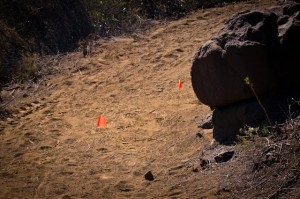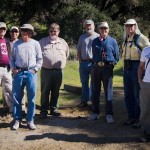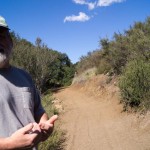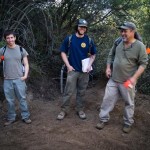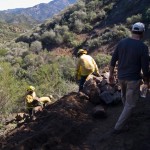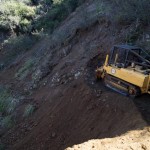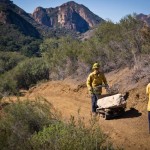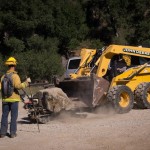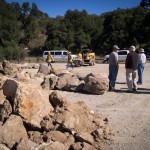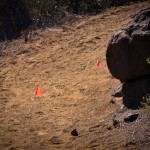
Stakeholders from several groups inspect the upgrades
On February 14, 2012, CORBA board member Steve Messer met with State Parks officials and representatives from hiking, conservation and equestrian groups. Together they walked the Tapia Spur trail which was slated for upgrades meet multiple use standards last year. The trail remains open to the public, though the work is well underway.
Originally constructed in the mid nineties, since being opened to multiple use there have been some reports of user conflicts, mostly due to excessive speed of bicycles. This was exacerbated by poor sight lines with blind corners and switchbacks. One of the significant trail upgrades is a reroute that will eliminate four switchbacks. The new section is still being machine cut, and like the rest of the trail, will be extensively hand-finished.
The entire trail is being re-cut to a 5′ width with a Sweco. Visibility is being improved on many sections by cutting back brush and, where appropriate, cutting back the backslope. The entire trail is being outsloped for improved drainage and to reduce long term maintenance needs.
The most significant change is the inclusion of approximately 17 “pinch points.” These consist of large 500 pound-plus rocks at least 18″ high strategically placed on the uphill side of blind corners. They will be embedded into the tread and placed about 36″ apart, in such a manner as to require a bicycle to weave between them. This will slow down cyclists at the spots with the most potential for startling of other trail users. These features are a key component of IMBA’s recommended speed control measures. They can add challenge and fun to a trail for cyclists, while allowing horses, hikers and personal mobility devices to pass easily. But most importantly, they improve the overall safety of the trail.
Another feature being added at key locations on the trail are rock-armored swales. The rock armoring leaves a rough tread while also protecting the natural drain from erosion by water or trail users. The rough tread is also expected to slow cyclists and add interest and challenge to the trail. Rocks were being imported from Malibu Canyon to create the pinch points, and harvested locally for the rock-armoring and rip-rap. The heavy rocks were being brought up the trail on mechanized carriers.
According to Knapp, “these features will slow cyclists and reduce the potential for them startling other trail users. We hope that good trail etiquette will then kick in and reduce conflict. However,” he continued, “we can’t control attitude or behavior.” We concur, and will continue encouraging proper etiquette through our outreach and education efforts, including our free Mountain Bike Skills Clinics.
Knapp also commented on the mission of the State Park to protect the natural resource. “Trails are there for people to enjoy the resource,” he said, “not for thrillseeking.” He talked about the fact that they must adapt to the changing trail user demographic, while keeping within their mission. These multi-use standards and the objective Change In Use process are a part of that adaptation to accommodate the growing number of off-road cyclists.
Everyone present seemed pleased with the trail improvements. “I like what I see,” remarked one of the Santa Monica Mountains Trails Council representatives “we’ll just need to give it a chance.”
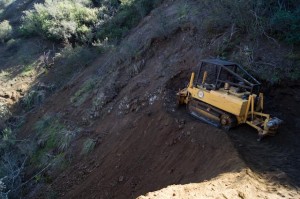
Tapia Spur Re-Route being cut
The trail improvements are not inexpensive, and funds are being funneled to this project from Sacramento. The State’s new Change In Use procedures will hinge upon their ability to implement these design standards on trails that are candidates for a change to multi-use, but currently closed to bikes. CORBA has a long-standing list of requests for trail Change In Use in the Santa Monica Mountains. While Tapia Spur was already designated multi-use, the upgrades will hopefully allay the concerns of the trail community at large about the pending changes to Lookout and Yearling trails. These two trails have been recommended for a change in use, and could be the next to receive such a treatment.
The trail will be showcased at the upcoming Parks Conference and the Trails and Greenways Conference. The work is expected to be completed by the first week of April. L.A. County is considering implementing a similar trail review process for County trails in the Fifth District. Overall, we believe improvements will not negatively impact the user experience for cyclists, and by reducing conflicts, they will in fact enhance the experience for all users.
Tags: Tapia Spur


